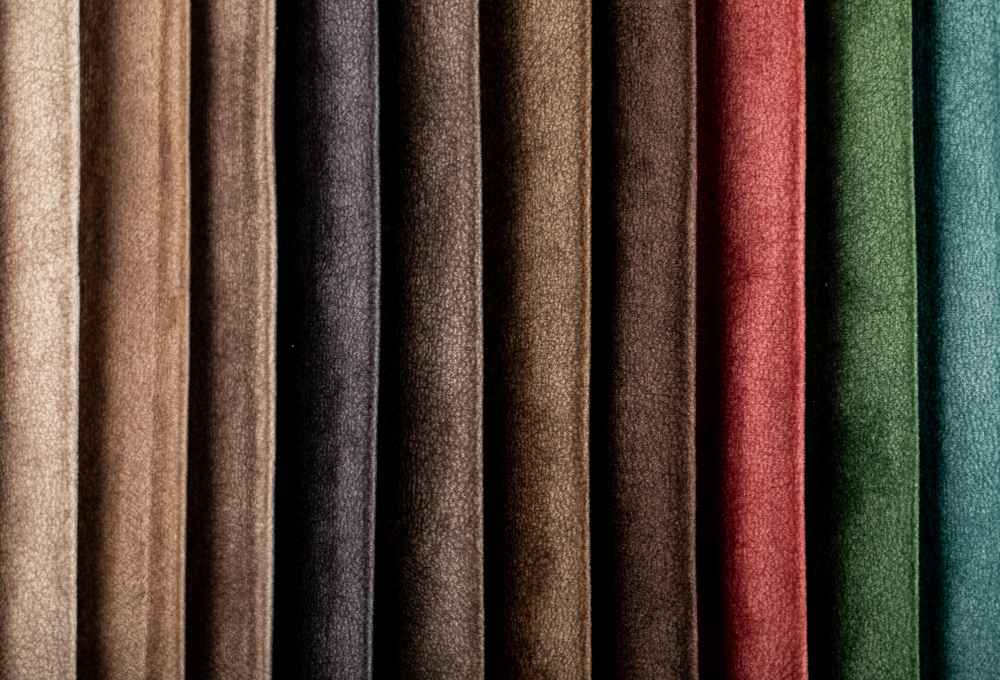Choosing the right upholstery fabric can feel overwhelming. You’re standing in a store or scrolling through countless options online, wondering which pattern won’t clash with your walls or which texture actually works with your existing furniture. The truth is, matching upholstery fabric with your home décor doesn’t require a design degree, it just needs a bit of planning and some practical know-how.
Whether you’re reupholstering an old armchair or picking fabric for a custom sofa, getting the match right makes all the difference. Let’s break down how to choose upholstery that fits seamlessly into your space.
Before you get excited about that bold floral print, take a good look around your room. What colors are already there? Your walls, curtains, rugs, and other furniture pieces have already established a color scheme, whether you planned it or not.
Pull colors from what you already have. If your walls are neutral beige and your rug has touches of blue, consider upholstery fabric that incorporates both. You don’t need an exact match—in fact, exact matches can look too coordinated and stiff. Instead, aim for colors that complement each other. A fabric with beige undertones and blue accents would tie everything together naturally.
Take photos of your room and bring them with you when fabric shopping. It sounds simple, but you’d be surprised how often people forget what shade of green their curtains actually are.
A formal living room has different needs than a family room where kids sprawl with snacks. Think about how the space gets used daily. High-traffic areas need durable, stain-resistant fabrics, while a bedroom chair that’s mostly decorative can handle something more delicate.
For busy households, performance fabrics are worth their weight in gold. They resist stains and wear without sacrificing style. Microfiber, treated cotton, and synthetic blends hold up well. Save the silk and linen for spaces that don’t see heavy use.
The room’s formality matters too. A velvet wingback chair fits perfectly in a traditional study but might feel out of place in a casual den with industrial décor.
Mixing patterns is where things get tricky, but it’s also where your room can go from boring to interesting. The key is balancing scale and style without creating visual chaos.
If you already have patterned curtains or a busy rug, choose upholstery fabric that’s either solid or has a much smaller or larger pattern. Having two medium-sized patterns competing for attention rarely works. A large floral sofa pairs well with small geometric throw pillows, while a striped chair can handle a large-scale paisley nearby if they share similar colors.
Stick to a maximum of three patterns in one space, and make sure they share at least one or two colors. This creates cohesion even when the patterns themselves are quite different.
Texture often gets overlooked, but it adds depth that flat surfaces can’t achieve. A room with all smooth fabrics feels one-dimensional, while incorporating varied textures makes it more inviting.
Pair smooth leather with nubby linen, or combine velvet with cotton canvas. In monochromatic rooms, texture becomes even more important since you’re not relying on color for interest. A cream-on-cream room with velvet cushions, linen upholstery, and a wool rug has plenty of visual variety.
Consider how textures feel too, not just how they look. If you have small children or pets, rough textures hide wear better than smooth ones where every scratch shows.
Light changes everything. That fabric sample that looked perfect in the store might look completely different in your living room. Natural light shows colors more accurately, while artificial light can shift tones considerably.
Northern light tends to be cooler and can make warm colors look dull. Southern light is warmer and can intensify colors. If possible, bring fabric samples home and look at them in your actual space at different times of day. Drape them over existing furniture and live with them for a day or two.
Incandescent bulbs add warmth and make reds and yellows richer, while LED lights vary depending on their color temperature. Make sure you’re seeing your fabric choices under the lighting you actually have.
If your décor is already colorful and busy, adding bold upholstery might push things over the edge. Conversely, if everything is neutral and safe, a statement piece can bring life to the room.
Think about creating a focal point. One stunning patterned chair in a neutral room draws the eye and adds personality without overwhelming. Or go the opposite route—keep upholstered furniture neutral and add personality through artwork, accessories, and accent pieces you can easily change.
There’s no right answer here, just what feels balanced to you. Some people love maximalist spaces packed with color and pattern, while others prefer calm, minimal rooms with just one or two interesting elements.
Your overall design style should guide fabric choices. A mid-century modern space calls for different upholstery than a farmhouse-style room or an eclectic bohemian one.
Traditional styles often feature classic patterns like damask, toile, or subtle stripes in refined colors. Modern and contemporary spaces lean toward solid colors, geometric patterns, or abstract designs with clean lines. Rustic and farmhouse styles work well with natural textures like linen and cotton in earthy tones.
That said, don’t feel trapped by style rules. A Victorian-era chair reupholstered in modern geometric fabric creates interesting contrast. Just make sure there’s something tying it to the rest of the room, whether that’s color, scale, or another design element.
Never order yards of upholstery fabric without seeing and feeling samples first. Colors on screens don’t translate accurately, and you can’t judge texture from a photo.
Order samples of your top choices and spend time with them. Drape them over your existing furniture, hold them up to your walls, and see them in different lighting. Check if they shed or pill easily by rubbing them between your fingers. If you have pets, test whether their fur shows up obviously on the fabric.
Most suppliers offer sample services for a small fee or sometimes free. It’s worth the wait and the few extra pounds to avoid costly mistakes.
Matching upholstery fabric with your home décor comes down to thoughtful observation and a bit of patience. Pay attention to your existing colors, consider how you actually use each space, and don’t be afraid to mix textures and patterns with purpose. Test samples in your own lighting, and trust your instincts about what feels right.
When you’re ready to start your search, you can consider Yorkshire Fabric Shop, an online destination for upholstery fabrics based in the United Kingdom. They offer a wide range of options that can work with various design styles and practical needs. The right fabric choice transforms not just a piece of furniture but the entire feel of your room. Take your time with the decision, and you’ll end up with upholstery you’ll love living with for years to come.
What’s the most durable upholstery fabric for families with children?
Performance fabrics like microfiber, treated polyester blends, and solution-dyed acrylics are your best bet. They resist stains and clean up easily. Look for fabrics with a high rub count (30,000 or more) which indicates better durability. Darker colors and patterns also hide stains better than light solids.
Can I mix different fabric types on furniture in the same room?
Absolutely. Mixing fabrics adds visual interest and keeps a room from looking too matchy. You might have a linen sofa, velvet chairs, and leather ottomans all working together. Just make sure they share some common element, similar colors, complementary textures, or a unified style—so the room feels cohesive.
How do I know if a pattern is too busy for my space?
Step back and look at the whole room. If the pattern makes it hard to focus or rest your eyes anywhere, it’s probably too busy. A good rule is that patterns should enhance the space, not dominate it. When in doubt, use busy patterns on smaller pieces and keep larger items more subdued.
Should upholstery fabric match or contrast with wall colors?
Either approach works depending on the effect you want. Matching creates a calm, cohesive flow, while contrasting makes furniture stand out as focal points. If your walls are bold, neutral upholstery provides balance. If walls are neutral, you have more freedom to go bold with furniture fabric.
How often should I replace upholstery fabric?
It depends on the fabric quality and how much use it gets. Quality upholstery in low-traffic areas can last 15-20 years, while family room furniture might need updating every 7-10 years. Replace fabric when it shows significant wear, permanent stains, or when you’re simply ready for a change in your décor.
Also read: Curtain Rods Dubai, Types, and Expert Installation

